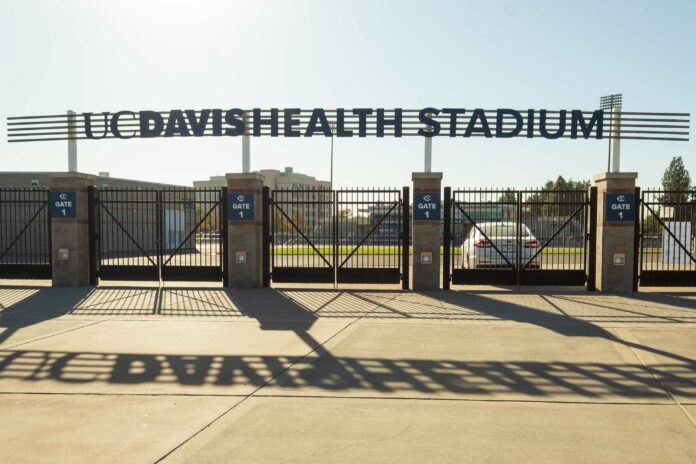Petition circulates to keep PE courses indirectly funded by student fees from the SASI referendum passed in 1994
A petition has been circling around social media platforms that protests UC Davis’ recent decision to terminate physical education (PE) classes.
“On Sept. 25, 2020, UC Davis made the sudden decision to eliminate the entire Physical Education program effective Winter Quarter 2021,” the petition reads. “This is a direct violation of the spirit of the SASI referendum and the understanding and intentions of the students who passed it in 1994.”
After budget cuts reduced funding for athletics, recreational sports and recreational services at UC Davis in the 1990s, ASUCD sponsored a referendum for a $34 student fee increase per quarter. The Student Activities and Services Initiative (SASI) was passed during a special election in 1994 after students voted to continue the fee as a temporary fund for Intercollegiate Athletics (ICA) and other recreation programs, according to the UC Davis Council on Student Affairs and Fees. The initiative also allocated funding for intramurals and sports clubs, recreation programs, the current Pavilion, the Equestrian Center, the Cross Cultural Center, the Women’s Resources and Research Center and Student Health Services.
In exchange for money diverted to ICA, students were promised for-credit PE classes. Students can enroll in physical fitness and sports courses paid by tuition, and can earn academic credit for their enrollment, rather than paying an additional fee for fitness classes. A report of the Academic Senate Special Committee on Athletics on April 17, 2012 outlines the cooperation between ICA coaches and the PE programs.
“[The physical education program] is an academic program in the College of Letters and Science,” the report reads. “It offers lower- and upper-division courses including the PE 1 activities courses and PE 6, the course associated with participation in intercollegiate athletes. Through the UC Davis teacher-coach model, the ICA coaches teach both of these courses.”
In response to a concerned student, Chief Campus Counsel Michael Sweeney wrote in an email that “no campus-based student fees are used to fund PE, and the elimination of the PE program will not affect the recreational offerings provided through Campus Recreation.”
Although funds from the SASI directly fund ICA and other recreation programs, Sweeney did not address the fact that funding ICA indirectly funds PE courses, because ICA coaches—whose salaries are at least partially funded by the SASI—teach PE courses.
“It’s not about student opportunity anymore, it’s about money,” said Paul Medved, a UC Davis almunnus who graduated in 1978 and father of a UC Davis swimmer who graduated in 2009.
Medved continued to explain the unique teacher-coach model of PE and club athletics at UC Davis.
“The UC Davis Intercollegiate Athletics program is very unique,” Medved said. “It is based on this teacher-coach model, and it involves a partnership with student fees and the university’s support of physical education. Coaches have master’s degrees and [qualify] as instructors and have to subscribe to the faculty code of conduct. Soon, that will get severed and replaced by mercenary coaches. It has nothing to do with the academic mission anymore.”
Medved explained that UC Davis ICA coaches who double as lecturers and PE teachers are subject to losing the coaching aspect of their salary if the PE program is cut. Medved has connections within the alumni association and involvement with members of UC Davis athletics who have received layoff letters. He noted that non-tenured professors are not likely to speak out.
“Everybody on the coaching staff is going to be subject to losing 30% of their salary,” Medved said.
Chancellor Gary May explained the reasoning behind the decision to eliminate PE classes in his “Thursday Thoughts” Instagram story series on Oct. 22.
“Well, first, I should say that the curriculum really belongs to the faculty and not to the Chancellor,” May said. “But, I do support the decision on PE, and here’s why: I think we should not look at it as something being taken away necessarily, because the only thing being taken away is your ability to earn credit for the activity—earn academic credit. We still plan on having a very robust portfolio of activities: physical activities, wellness activities [and] mental health activities available through campus recreation.”
Students will continue to pay the SASI student fee, but the fee will no longer indirectly fund unit-earned PE courses.
“I’d like to have a Business Degree for undergraduates, for example,” May said in his post. “I’d like to have Data Science for undergraduates, for example. And we can’t do these things with finite, scarce resources. We have to make some choices in order to be able to do all those things.”
Petition organizers argue this is unfair considering the 1994 ASUCD Senate intended the funds from the SASI referendum be allocated specifically to PE courses.
Claire Klyver, a third-year neurobiology, physiology and behavior major who organized the petition circulating on social media, is concerned for her PE teacher amid the budget reallocation plan.
“I am confused why the student body wasn’t told initially that the program was ending,” Klyver said. “ASUCD should be the liaison between the administration and the students.”
Written by: Hannah Blome — campus@theaggie.org



